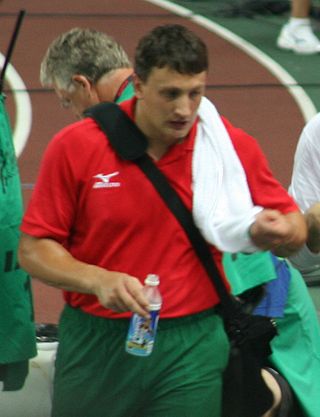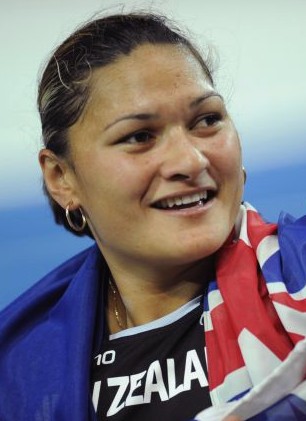
The discus throw, also known as disc throw, is a track and field sport in which the participant athlete throws an oblate spheroid weight — called a discus — in an attempt to mark a farther distance than other competitors. It is an ancient sport, as demonstrated by the fifth-century-BC Myron statue Discobolus. Although not part of the current pentathlon, it was one of the events of the ancient Greek pentathlon, which can be dated back to at least 708 BC, and it is part of the modern decathlon.

The javelin throw is a track and field event where the javelin, a spear about 2.5 m in length, is thrown as far as possible. The javelin thrower gains momentum by running within a predetermined area. Javelin throwing is an event of both the men's decathlon and the women's heptathlon.

The hammer throw is one of the four throwing events in regular outdoor track and field competitions, along with the discus throw, shot put and javelin.

The decathlon is a combined event in athletics consisting of 10 track and field events. The word "decathlon" was formed, in analogy to the word "pentathlon", from Greek δέκα and ἄθλος. Events are held over two consecutive days and the winners are determined by the combined performance in all. Performance is judged on a points system in each event, not by the position achieved. The decathlon is contested mainly by male athletes, while female athletes typically compete in the heptathlon.

Athletics is a sport that includes athletic contests based on running, jumping, and throwing skills. The name used in North America is derived from where the sport takes place, a running track and a grass field for the throwing and some of the jumping events. Track and field is categorized under the umbrella sport of athletics, which also includes road running, cross country running and racewalking. In British English the term athletics is synonymous with American track and field and includes all jumping events. Outside of Canada and the United States, athletics is the official term for this sport with 'track' and 'field' events being subgroups of athletics events.

The pentathlon or women's pentathlon is a combined track and field event in which each woman competes in five separate events over one day. The distance or time for each event is converted to points via scoring tables, with the overall ranking determined by total points. Since 1949 the events have been sprint hurdling, high jump, shot put, long jump, and a flat race. The sprint hurdles distance was 80 m outdoors until 1969 and thereafter 100 m; in indoor pentathlon the distance is 60 m. The flat race was 200 m until 1976 and thereafter 800 m. In elite-level outdoor competition, the pentathlon was superseded in 1981 by the heptathlon, which has seven events, with both 200 m and 800 m, as well as the javelin throw. Pentathlon is still contested at school and masters level and indoors.

Andreas Thorkildsen is a retired Norwegian track and field athlete who competed in the javelin throw. He was the Olympic Champion in 2004 and 2008, European Champion in 2006 and 2010, and World Champion in 2009. He is the first male javelin thrower in history to simultaneously be European, World and Olympic Champion. He was also a three-time silver medalist at the World Championships, placing second in 2005, 2007 and 2011. His personal best of 91.59 m, set in 2006, is the Norwegian record.

Ivan Ryhoravich Tsikhan is a Belarusian hammer thrower. He is a two-time world champion and an Olympic medalist.

Dame Valerie Kasanita Adams is a retired New Zealand shot putter. She is a four-time World champion, four-time World Indoor champion, two-time Olympic, three-time Commonwealth Games champion and twice IAAF Continental Cup winner. She has a personal best throw of 21.24 metres (69.7 ft) outdoors and 20.98 metres (68.8 ft) indoors. These marks are Oceanian, Commonwealth and New Zealand national records. She also holds the Oceanian junior record (18.93 m) and the Oceanian youth record (17.54 m), as well as the World Championships record, World Indoor Championships record and Commonwealth Games record.
Rosa Andreína Rodríguez Pargas is a Venezuelan hammer thrower. She is the Venezuelan record holder for the event with her personal best of 72.83 metres, set in May 2012, which she improved to 73.64 in 2013. Rodríguez represented Venezuela at the World Championships in Athletics in 2007, 2009, 2013 and 2015.

David Storl is a German track and field athlete who specialises in the shot put. He was successful on the youth and junior athletics circuit, winning gold medals at the World Youth Championships and World Junior Championships. Storl won his first senior medal, a silver, at the 2011 European Athletics Indoor Championships.

Sandra Elkasević is a Croatian discus thrower. She is a two-time Olympic and world champion and a record seven-time European champion which makes her the most decorated female discus thrower in history. She is also a seven-time Diamond League winner, prevailing in 46 circuit's meetings.

Julius Yego is a Kenyan track and field athlete who competes in the javelin throw. Nicknamed "Mr. YouTube" because he learned how to throw by watching YouTube videos of javelin athletes, Yego is the African record holder for the event with a personal best of 92.72 m.

Ronald Odair de Oliveira Julião is a Brazilian track and field athlete who competes in the shot put and discus throw. He is a member of BM&F Bovespa's track club and is trained by João Paulo Alves da Cunha. He is the Brazilian record holder in the discus throw (65.55 m). He is the second highest ranked South American discus thrower after Jorge Balliengo and has won straight titles at the Brazil championships since 2005.
Denia Caballero Ponce is a Cuban athlete who competes in the discus throw. She has a personal best of 70.65 metres for the event. She won the gold medal at the 2015 and the silver medal at the 2019 World Championships and was the bronze medalist at the 2016 Summer Olympics. Caballero also was the Central American and Caribbean champion in 2011 and the 2011 Pan American Games bronze medallist.

Apostolos Parellis is a Cypriot track and field athlete specializing in discus throw. He is the current Cypriot national record holder with 66.32 m since October 2019.

Tomas Walsh is a New Zealand athlete who competes mainly in the shot put. He is the current national record holder both outdoors and indoors for the event. His personal best of 22.90 m, set in Doha, 5 October 2019, is also the Oceanian record and makes him the seventh best shot putter in history.
The 2006 USA Outdoor Track and Field Championships was organised by USA Track & Field and held from June 22 to 25 at the IU Michael A. Carroll Track & Soccer Stadium in Indianapolis, Indiana. The four-day competition served as the national championships in track and field for the United States. As there was no Summer Olympics or World Championships in Athletics held that year, the competition did not serve as a national team selection event.














